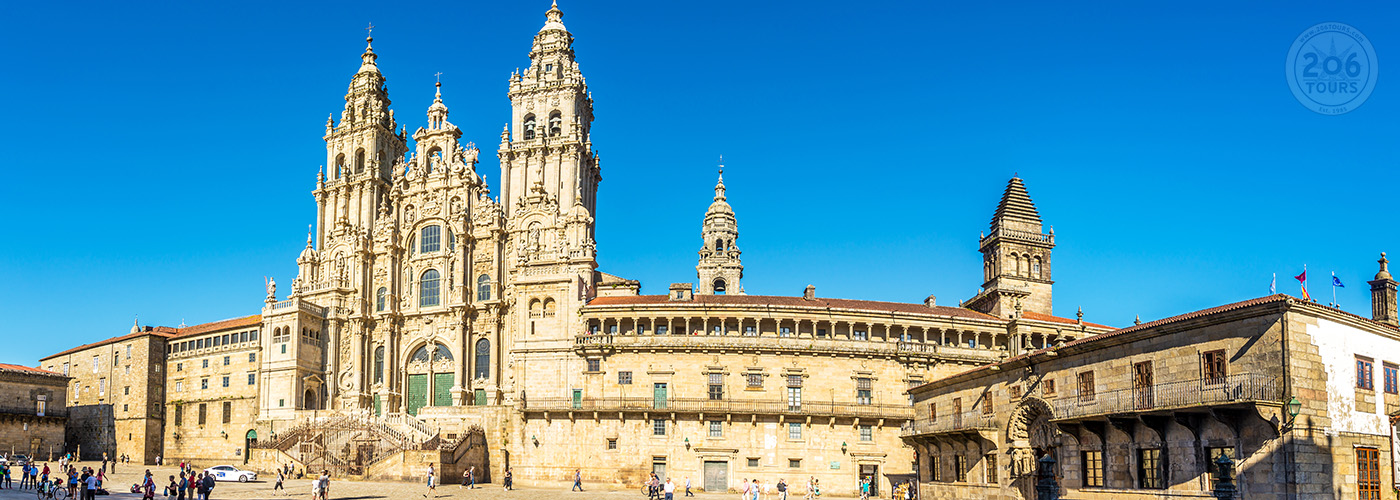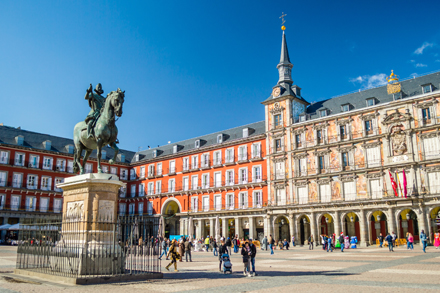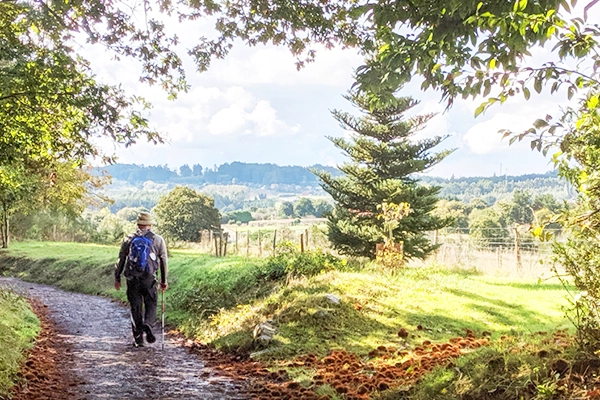
El Camino de Santiago
El Camino de Santiago, also known as the Way of St. James, is a network of pilgrimages leading to the shrine of the apostle Saint James the Great in the cathedral of Santiago de Compostela in Galicia in northwestern Spain. The history of these routes is rich and complex, deeply intertwined with the traditions and history of Catholicism.
The pilgrimage to Santiago has never been a single route but a network of paths from various starting points across Europe. The most popular route, the Camino Francés (French Way), begins at Saint-Jean-Pied-de-Port in France, while others begin in Portugal, Spain, and even as far away as England and Germany.
The history of the Camino de Santiago dates back to the discovery of what is believed to be the tomb of St. James the Great in the 9th century. According to legend, a hermit named Pelayo saw a star or field of stars that led him to a forgotten Roman tomb in the field of Libredón. Bishop Theodemar of Iria recognized this as the tomb of the apostle James and declared it a site of pilgrimage. The name “Compostela” itself is thought to derive from the Latin “Campus Stellae” (Field of the Star).
News of the discovery spread throughout Christendom, reaching the ears of King Alfonso II of Asturias and Galicia. He became the first recorded pilgrim to Santiago de Compostela in 814 AD, traveling from his capital at Oviedo, a route now known as the Camino Primitivo (Primitive Way). He confirmed the discovery and ordered the construction of a church on the site, which would eventually develop into the grand Cathedral of Santiago de Compostela.
The 10th and 11th centuries saw a surge in the popularity of the pilgrimage. This increase was partly due to the political and religious efforts of European leaders. Promoting the Way of St. James served to unify Christian kingdoms against the Moorish invaders in Spain, a concept known as the Reconquista. The pilgrimage was also a major part of the Cluniac Reforms of the 10th century, a movement aimed at strengthening the power of the Papacy over the feudal lords.
During the Middle Ages, the pilgrimage to Santiago de Compostela was considered one of the three most important Christian pilgrimages, alongside those to Jerusalem and Rome. During this time, numerous hospitals, monasteries, and inns were built along the route to support the influx of pilgrims, and the scallop shell became recognized as the symbol of the pilgrimage.
The popularity of the Camino de Santiago waned in later centuries due to political instability, wars, and outbreaks of disease. However, it saw a revival in the late 20th and early 21st centuries. In 1987, the route was declared the first European Cultural Route by the Council of Europe; it was later named a UNESCO World Heritage Site. Today, hundreds of thousands of people make the pilgrimage each year for religious, spiritual, and cultural reasons.
The Camino de Santiago has been a significant part of Catholic tradition for over a millennium. As a pilgrimage, it represents a journey of penance, reflection, and spiritual growth. Moreover, it reflects the broader Catholic belief in pilgrimages as an act of devotion and a path to spiritual enlightenment.
El Camino de Santiago, also known as the Way of St. James, is an incredible journey that every Catholic should consider undertaking at least once in their life. Here are a few reasons why:
1. Deep Spiritual Significance: Walking the El Camino is an act of penance, faith, and spiritual growth. It’s a pilgrimage that traces the footsteps of the apostle St. James, who spread the Gospel across Spain. It’s an opportunity to reflect on your faith and your life, and to deepen your relationship with God.
2. Historical Significance: The Camino has been walked by pilgrims for over a thousand years, making it a journey through history as well as faith. The path leads through ancient towns and past countless churches, monasteries, and landmarks, each with their own story to tell.
3. Community: Along the Camino, you’ll encounter other pilgrims from all around the world, each with their own stories and reasons for walking. It’s a wonderful opportunity to connect with fellow believers and to experience the universal nature of the Catholic faith.
4. Physical and Mental Challenge: The Camino is also a physical journey that can test your limits and help you discover your inner strength. It’s an opportunity to detach from the fast-paced modern world, find peace in solitude, and gain mental clarity.
5. Beautiful Scenery: The Camino passes through some of the most stunning landscapes in Spain, from the Pyrenees mountains to the vineyards of La Rioja to the green hills of Galicia. It’s a feast for the eyes as well as the soul.
As for why 206 Tours Inc is the best option for this pilgrimage:
1. Expertise: 206 Tours Inc specializes in Catholic pilgrimages. They have been organizing tours for over 30 years and have a deep understanding of the spiritual and logistical aspects of such journeys.
2. Comprehensive Packages: 206 Tours Inc offers packages that cover everything from airfare, accommodations, meals, and local transportation, to guided tours at significant sites. This allows you to focus on your spiritual journey without worrying about logistics.
3. Spiritual Guidance: Each tour comes with a Catholic priest who serves as a spiritual director, offering daily Mass and opportunities for confession and spiritual guidance. This enriches the pilgrimage experience and provides spiritual support throughout the journey.
4. Flexibility: 206 Tours Inc offers various options for the Camino, including different starting points and lengths, so you can choose the one that best fits your physical ability and time constraints.
5. Customer Service: 206 Tours Inc is known for its excellent customer service. Their team is available 24/7 during your trip to ensure your safety and comfort.
In conclusion, walking the El Camino de Santiago is a profound way to deepen your Catholic faith and connect with its history. And 206 Tours Inc’s expertise, comprehensive packages, spiritual guidance, flexibility, and excellent customer service make it the best option for this sacred journey.
Tours visiting El Camino
El Camino - The Way of St. James: The Spanish Route (Walking Pilgrimage)
Madrid * Foncebadon * Iron Cross * O Cebreiro * Sarria * Portomarin * Palas de Rei * Arzua * Arca do Pino * Monte do Gozo * Santiago de Compostela (St. James)
| Duration | Destination |
|---|---|
| 11 Days | Spain |
El Camino - The Way of St. James, Fatima, Spain, Lourdes & Paris
Madrid * Foncebadon * Iron Cross * O Cebreiro * Sarria * Portomarin * Palas de Rei * Arzua * Arca do Pino * Monte do Gozo * Santiago de Compostela (St. James) * Lisbon (St. Anthony )* Santarem (Eucharistic Miracle) * Fatima * Salamanca * Alba de Tormes * Avila (St. Teresa) * Burgos * Loyola (St. Ignatius) * Lourdes (St. Bernadette) * Paris * Lisieux (St. Therese the Little Flower) * Normandy * Chartres
| Duration | Destination |
|---|---|
| 23 Days | Spain, Portugal, France |
El Camino - The Way of St. James: The French Route (Walking Pilgrimage)
Madrid * Burgos * Leon * Villadongos del Paramo * Astorga * Rabanal del Camino * Ponferrada * Villafranca del Bierzo * O Cebreiro * Triacastela * Sarria * Portomarin * Palas de Rei * Arzua * Arca do Pino/Rua * Monte do Gozo * Santiago de Compostela (St. James)
| Duration | Destination |
|---|---|
| 20 Days | Spain |



